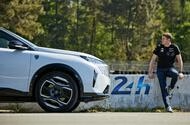Experiencing the Circuit de la Sarthe: Paul di Resta’s Unique Perspective
Paul di Resta is no stranger to the Circuit de la Sarthe, having raced in the iconic 24 Hours of Le Mans five times. However, his recent drive around this legendary track was unlike any other. Instead of the high-speed thrills of his Peugeot 9X8 hypercar, he found himself navigating the circuit in a Peugeot e-3008, a stark contrast that turned this lap into a leisurely exploration rather than a race against time.
What’s it like to drive Le Mans at a crawl?
Imagine the Mulsanne Straight, a stretch that usually sees hypercars soaring at speeds close to 200 mph. This time, though, di Resta was met not with fellow racers but with everyday traffic—SUVs, hatchbacks, and even an e-scooter. It’s a surreal scene for a driver accustomed to the adrenaline of competitive racing. The e-3008, while a capable vehicle, certainly doesn’t deliver the same rush as its racing counterpart. Yet, it serves a purpose: it’s road-legal and can comfortably accommodate more than one passenger.
The Circuit de la Sarthe is unique in that much of it doubles as public roads for most of the year. The Mulsanne Straight, for instance, is part of the D338, which means anyone can experience it—albeit at a much slower pace. Di Resta’s lap began not on the main straight but on the Boulevard des Italiens, a bustling area usually packed with fans during race week. He noted how different it felt without the usual race-day chaos, where moving through the crowd can take ages.
What makes the Mulsanne Straight so special?
As they approached the Mulsanne, di Resta explained the importance of a good exit from the corner leading onto the straight. Originally a long, uninterrupted stretch, the Mulsanne now features two chicanes designed to keep speeds in check. While driving at a leisurely pace, di Resta took the opportunity to examine the kerbs closely, noting their jagged edges. In a race, he would typically avoid them to maintain stability and avoid damaging the car.
The challenge of endurance racing becomes even more pronounced as night falls. Di Resta reflected on how daunting it can be for younger drivers, especially when racing in the dark. He recalled his own experiences and how, with time, he grew more comfortable with the night conditions. It’s a testament to the mental fortitude required in endurance racing—something that can’t be underestimated.
How did di Resta transition from F1 to endurance racing?
Di Resta’s journey to endurance racing is quite fascinating. Initially focused on single-seater racing, he didn’t see Le Mans as part of his future. However, an invitation from Zak Brown of McLaren to race in the LMP2 class changed everything. After winning the class at Le Mans in 2020, he became a key driver for Peugeot in the World Endurance Championship, showcasing his adaptability and skill across different racing formats.
What’s the significance of the Porsche Curves?
As they drove through the Porsche Curves, di Resta expressed his admiration for this section of the track. It’s technically demanding and crucial for securing a good lap time. He emphasized how television often fails to convey the true speed and complexity of these curves. For drivers, it’s a test of both skill and strategy, especially when navigating traffic during a race.
Despite the challenges Peugeot has faced in the Hypercar division, di Resta remains optimistic. The team has made significant updates to the 9X8, but early results have been mixed. The competitive landscape of the World Endurance Championship is fierce, with numerous manufacturers vying for supremacy. Yet, di Resta knows that anything can happen at Le Mans, where the unique characteristics of the circuit can turn the tide in unexpected ways.
What’s the takeaway from di Resta’s experience?
Driving the Circuit de la Sarthe at a leisurely pace provided di Resta with a fresh perspective on a track he knows intimately. It’s a reminder that racing isn’t just about speed; it’s about understanding the nuances of the environment and adapting to ever-changing conditions. As he prepares for the upcoming race, he carries with him the lessons learned from this unique experience.
The big takeaway? Racing isn’t just about the thrill of speed—it’s about the journey, the learning, and the love for the sport. Whether you’re behind the wheel of a hypercar or a family SUV, there’s always something new to discover. So, take a moment to appreciate the ride, and who knows? You might just find joy in the journey itself.

